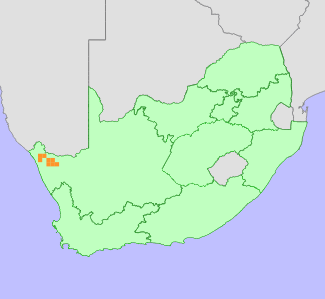|
Scientific Name | Conophytum wettsteinii (A.Berger) N.E.Br. |
Higher Classification | Dicotyledons |
Family | AIZOACEAE |
Synonyms | Conophytum brevipes L.Bolus, Conophytum circumpunctatum Schick & Tischer |
National Status |
Status and Criteria | Critically Endangered A4cd |
Assessment Date | 2021/12/10 |
Assessor(s) | A.J. Young, P.G. Desmet, I. Ebrahim, D. Guo, A. Harrower, L. Jabar, L. Knoetze, C. Rodgerson, P.C.V. Van Wyk & N.N. Mhlongo |
Justification | This succulent species is endemic to the Northern Cape province of South Africa where it has an extent of occurrence (EOO) of 3,018 km2 and area of occupancy (AOO) of 96 km2. The population is in decline due to illegal collection of plants from habitat for the international trade in ornamental succulents, and several thousand plants have been removed from habitat since 2019. Collection is likely to increase as there has been a dramatic increase in the number of species and volume of plants targeted since 2019. The continued threat of illegal collection is therefore regarded as very high for this particular species and a decline of at least 80% of the population is likely within the next three generations (90 years). Modelling of climate change impacts is predicted to result in a 71% loss of suitable bio-climatic habitat by 2080 under likely CO2 emission scenarios (RCP 2.6). It therefore qualifies as Critically Endangered under criterion A4. |
Distribution |
Endemism | South African endemic |
Provincial distribution | Northern Cape |
Range | This dwarf succulent species is endemic to the Richtersveld region of the Northern Cape Province of South Africa where it is known from numerous locations. |
Habitat and Ecology |
Major system | Terrestrial |
Major habitats | Succulent Karoo |
Description | This succulent is endemic to the Succulent Karoo biome where it is found in both the Richtersveld and Namaqualand Hardeveld bioregions. The plants are found both in full sun and in shaded cracks and crevices on exposed areas of gneiss or granite and amongst quartz stones.
This species has a generation length of 30 years. It is expected to be sensitive to the impacts of climate change as it does not disperse and while adapted to arid conditions, is dependent on limited seasonal rainfall. Species in the genus are sensitive to long periods of drought. Drought related mortality has been observed for other closely related taxa within the genus. |
Threats |
| Plants have been subject to illegal collection of mature individuals for the international trade in ornamental succulents with several thousand plants being removed since 2019. This species has been highly sought after by collectors and is highly likely to remain so in future. At least 8,000 mature individuals have been illegally removed from habitat since 2019. As a result a population decline of up to 80% is suspected over three generations (90 years).
Anthropogenic climate change is a long-term threat to this species. Loss of vegetation cover has been observed across the geographic range occupied by this species via Landsat imagery between 1984 and 2018 indicating a decline in habitat quality. Climate models for the likely emission scenarios where emissions stay at present day levels (RCP 2.6) (Hausfather and Peters 2020) and worst case scenarios where emissions continue to increase during the 21st century (RCP 8.5) indicate that there will be a loss of suitable bioclimatic envelope of between 91% and 100% by 2080 for this species. However, as this taxon occurs across several vegetation units it is expected to have a level of resilience to climate change and the expected population loss is reduced by 20% to 71%. Species in this genus have limited dispersal ability and migration to suitable habitats elsewhere is regarded as highly unlikely. |
Population |
It is widespread usually occurring as scattered individuals or small colonies, but it is also sometimes locally abundant. The subpopulations range in size from a few dozen plants to 1,000 or more. The total population is likely to consist of between 50,000 and 100,000 mature individuals. The population is in decline due to illegal collection for the ornamental succulent plant trade. At least 8,000 plants have been removed from habitat between 2019 and the end of 2021 based on confiscation records, with many more having likely been removed but not intercepted by law enforcers.
|
Population trend | Decreasing |
Assessment History |
Taxon assessed |
Status and Criteria |
Citation/Red List version | | Conophytum wettsteinii (A.Berger) N.E.Br. | Least Concern | Raimondo et al. (2009) | |
Bibliography |
Hammer, S.A. 1993. The genus Conophytum: A conograph. Succulent Plant Publications, Pretoria.
Hausfather, Z. and Peters, G.P. 2020. Emissions - the 'business as usual' story is misleading. Nature 577(618-620).
Opel, M.R. 2004. The rediscovery of Crassula alcicornis. Haseltonia 10:38-40.
Raimondo, D., von Staden, L., Foden, W., Victor, J.E., Helme, N.A., Turner, R.C., Kamundi, D.A. and Manyama, P.A. 2009. Red List of South African Plants. Strelitzia 25. South African National Biodiversity Institute, Pretoria.
Snijman, D.A. 2013. Plants of the Greater Cape Floristic Region 2: The extra Cape flora. Strelitzia 30. South African National Biodiversity Institute, Pretoria.
|
Citation |
| Young, A.J., Desmet, P.G., Ebrahim, I., Guo, D., Harrower, A., Jabar, L., Knoetze, L., Rodgerson, C., Van Wyk, P.C.V. & Mhlongo, N.N. 2021. Conophytum wettsteinii (A.Berger) N.E.Br. National Assessment: Red List of South African Plants version . Accessed on 2025/08/25 |
 Comment on this assessment
Comment on this assessment


